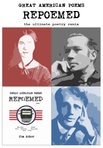Teaching Poetry -- Part 2
In a blog entry on June 11, 2012, I wrote about how I introduce poetry to students with “l(a,” a poem by E. E. Cummings. After I cover “l(a” with them, they are always eager for more poetry, and they are especially eager for more Cummings. I generally follow-up with Cummings’ “old age sticks,” and kids love interpreting the meaning and implications of the poem:
old age sticks
up Keep
Off
signs)&
youth yanks them
down(old
age cries No
Tres)&(pas)
youth laughs
(sing
old age
scolds Forbid
den Stop
Must
n't Don't
&)youth goes
right on
gr
owing old
Before I begin any discussion of the poem, though, I set the stage by explaining that there are TWO VERY IMPORTANT WORDS in the poem – TWO WORDS that elevate the poem beyond its fundamental meaning. Then we start the conversation.
Of course, students quickly pick up on the aspects of the poem that convey old age versus youth, and it’s always fun to discuss generational differences (especially with examinations of music, dance, clothing, hair styles, trends, fads, and so on). Particularly astute students notice that all of the language in the poem representing “old age” is confined within parentheses while the words representing “youth” are not.
After we examine the words, the mechanics and the structure of the poem, I remind them about the TWO VERY IMPORTANT WORDS– and the students try to figure out what I’m talking about. We examine their ideas, and then I underline what I think are the TWO VERY IMPORTANT WORDS: “owing old” – taken from the words “growing old” in the final two lines of the poem.
I explain that while there are always generational differences and that teenagers always rebel and stretch the limits, they really “owe” those who came before them: What past musicians influenced the styles of current musicians? What past artists paved the way for the work of contemporary artists? What historical thinkers opened doors for the ideas of modern-day thinkers?
Yes, there are always generational gaps and rifts – but youth “goes right on growing old” – just as we are all always “owing old.”
old age sticks
up Keep
Off
signs)&
youth yanks them
down(old
age cries No
Tres)&(pas)
youth laughs
(sing
old age
scolds Forbid
den Stop
Must
n't Don't
&)youth goes
right on
gr
owing old
Before I begin any discussion of the poem, though, I set the stage by explaining that there are TWO VERY IMPORTANT WORDS in the poem – TWO WORDS that elevate the poem beyond its fundamental meaning. Then we start the conversation.
Of course, students quickly pick up on the aspects of the poem that convey old age versus youth, and it’s always fun to discuss generational differences (especially with examinations of music, dance, clothing, hair styles, trends, fads, and so on). Particularly astute students notice that all of the language in the poem representing “old age” is confined within parentheses while the words representing “youth” are not.
After we examine the words, the mechanics and the structure of the poem, I remind them about the TWO VERY IMPORTANT WORDS– and the students try to figure out what I’m talking about. We examine their ideas, and then I underline what I think are the TWO VERY IMPORTANT WORDS: “owing old” – taken from the words “growing old” in the final two lines of the poem.
I explain that while there are always generational differences and that teenagers always rebel and stretch the limits, they really “owe” those who came before them: What past musicians influenced the styles of current musicians? What past artists paved the way for the work of contemporary artists? What historical thinkers opened doors for the ideas of modern-day thinkers?
Yes, there are always generational gaps and rifts – but youth “goes right on growing old” – just as we are all always “owing old.”
No comments have been added yet.



